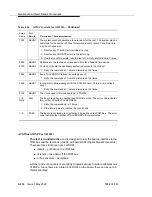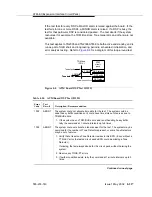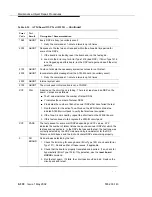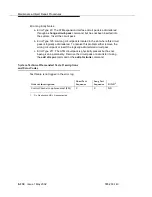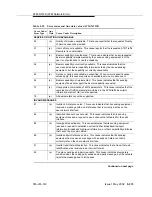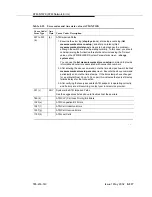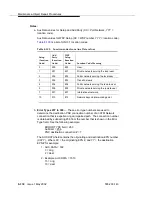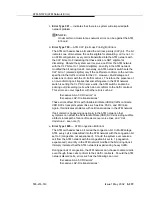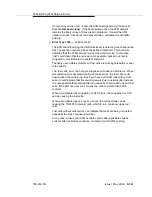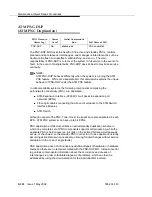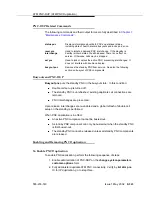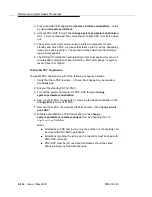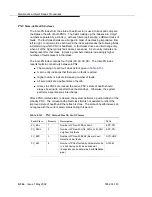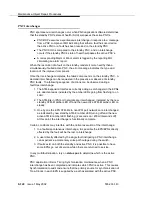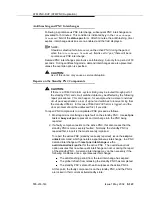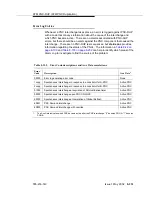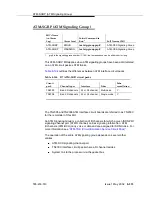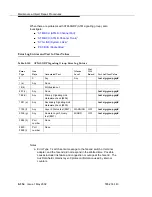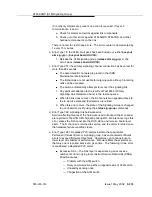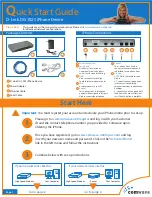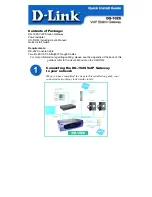
Maintenance-Object Repair Procedures
555-233-143
8-240
Issue 1 May 2002
These errors affect SVCs with Variable Bit Rate (VBRnt) traffic contracts.
VBR SVCs transport system links such as EAL, PACL, and PRI links.
Symptoms that can affect the Constant Bit Rate (CBR) SVCs include
audible artifacts in talk paths, failure of modems over voice lines, and “cell
Underruns” – see note (f).
f. Error Type 1281 — ATM Cell Underruns
MultiVantage ATM monitors for cell underrun conditions on SVCs with
Constant Bit Rate (CBR) traffic contracts or on ATM CES trunks. In either
case, cells are expected to arrive at a fixed rate. If cells arrive below that
rate, an underrun condition exists. The most likely cause of cell underruns
is a problem with cell transmission through the ATM network.
Possible symptoms include audible artifacts in talk paths and failure of
modems over voice lines. If cell loss is happening generically in the ATM
network, other symptoms like “excessive AAL-5 CRC errors” or “excessive
LAP-D retransmissions” are possible on SVCs with Variable Bit Rate
(VBRnt) traffic contracts. The VBR SVCs transport system links such as
EAL, PACL, and PRI links.
Another ATM board within the system originally generated the arriving cells
at the specified traffic contract rate. In order to have arrived at a lower rate,
these cells were either slowed during transmission or possibly discarded by
the ATM network. This indicates problems with cell transmission in the
ATM network. Consult the ATM network vendor. Ask about cell delay
variation, cell discard, and traffic policing.
Cell underruns often happen in conjunction with cell overruns. If both
occur, it further indicts the ATM network.
g. Error Type 1537 — ATM Cell Overruns
MultiVantage ATM monitors for cell overrun conditions on SVCs with
Constant Bit Rate (CBR) traffic contracts or on ATM CES trunks. In either
case, cells are expected to arrive at a fixed rate. If cells arrive above that
rate, an overrun condition exists. The most likely cause of cell overruns is
a problem with cell transmission through the ATM network.
Both cell underruns and overruns are typical symptoms of cell transmission
problems like cell jitter or delay. The ATM board attempts to compensate
somewhat by buffering cells. However, if the ATM network transmission
delays are high, the board could conclude that it has seen a cell overrun
because it has exhausted all of its buffer space.
If cell underruns or both cell underruns and overruns occur, indict the ATM
network. Consult the ATM vendor. Ask about cell delay variation, cell
discard, and traffic policing.
Another much less likely cause of cell overruns is that an ATM board is
generating cells above the traffic contract rate. Suppose, a board
somehow generates cells too quickly. The ATM network likely reacts by at
least setting the CLP bit in the cells that exceed the traffic contract (see
note (d) for ATM CLP errors). The ATM network can also discard the
excess cells.
Summary of Contents for S8700 Series
Page 50: ...Maintenance Architecture 555 233 143 1 26 Issue 1 May 2002 ...
Page 74: ...Initialization and Recovery 555 233 143 3 12 Issue 1 May 2002 ...
Page 186: ...Alarms Errors and Troubleshooting 555 233 143 4 112 Issue 1 May 2002 ...
Page 232: ...Additional Maintenance Procedures 555 233 143 5 46 Issue 1 May 2002 ...
Page 635: ...status psa Issue 1 May 2002 7 379 555 233 143 status psa See status tti on page 7 406 ...
Page 722: ...Maintenance Commands 555 233 143 7 466 Issue 1 May 2002 ...

